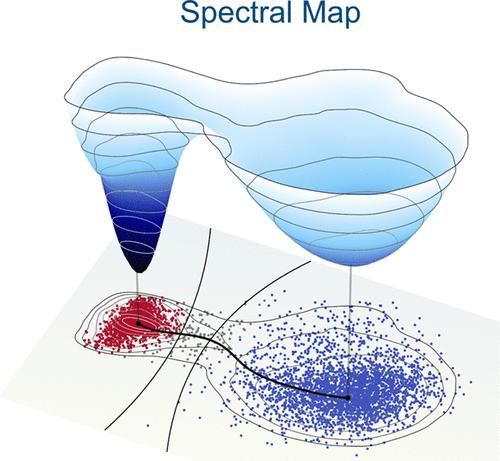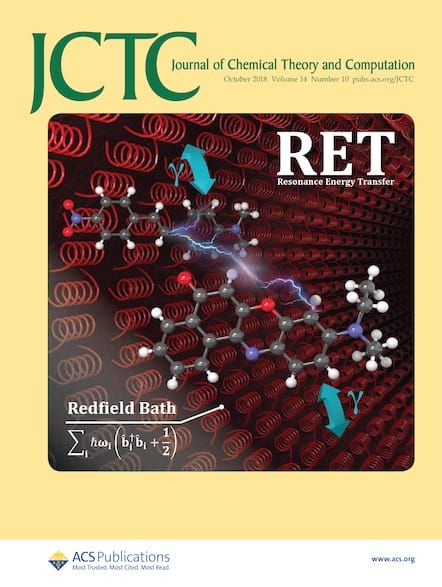Spectral Map for Slow Collective Variables, Markovian Dynamics, and Transition State Ensembles
IF 5.7
1区 化学
Q2 CHEMISTRY, PHYSICAL
引用次数: 0
Abstract
Understanding the behavior of complex molecular systems is a fundamental problem in physical chemistry. To describe the long-time dynamics of such systems, which is responsible for their most informative characteristics, we can identify a few slow collective variables (CVs) while treating the remaining fast variables as thermal noise. This enables us to simplify the dynamics and treat it as diffusion in a free-energy landscape spanned by slow CVs, effectively rendering the dynamics Markovian. Our recent statistical learning technique, spectral map [Rydzewski, J. J. Phys. Chem. Lett. 2023, 14(22), 5216–5220], explores this strategy to learn slow CVs by maximizing a spectral gap of a transition matrix. In this work, we introduce several advancements into our framework, using a high-dimensional reversible folding process of a protein as an example. We implement an algorithm for coarse-graining Markov transition matrices to partition the reduced space of slow CVs kinetically and use it to define a transition state ensemble. We show that slow CVs learned by spectral map closely approach the Markovian limit for an overdamped diffusion. We demonstrate that coordinate-dependent diffusion coefficients only slightly affect the constructed free-energy landscapes. Finally, we present how spectral maps can be used to quantify the importance of features and compare slow CVs with structural descriptors commonly used in protein folding. Overall, we demonstrate that a single slow CV learned by spectral map can be used as a physical reaction coordinate to capture essential characteristics of protein folding.

慢速集合变量、马尔可夫动力学和过渡态集合的谱图
理解复杂分子系统的行为是物理化学的一个基本问题。要描述这类系统的长期动力学特征(这是其信息量最大的特征),我们可以确定少数慢速集体变量(CV),同时将其余快速变量视为热噪声。这样,我们就能简化动力学,将其视为慢速集体变量所跨越的自由能景观中的扩散,从而有效地呈现马尔可夫动力学。我们最近的统计学习技术--谱图[Rydzewski, J. J. Phys. Chem. Lett.在这项工作中,我们以蛋白质的高维可逆折叠过程为例,为我们的框架引入了几项进展。我们实施了一种粗粒化马尔可夫转换矩阵算法,从动力学角度划分了慢速 CV 的缩小空间,并用它定义了一个转换状态集合。我们证明,通过谱图学习到的慢速 CV 非常接近过阻尼扩散的马尔可夫极限。我们证明,与坐标相关的扩散系数只会对构建的自由能谱产生轻微影响。最后,我们介绍了如何利用光谱图量化特征的重要性,并将慢速 CV 与蛋白质折叠中常用的结构描述符进行了比较。总之,我们证明了通过光谱图学习到的单个慢速 CV 可用作物理反应坐标,以捕捉蛋白质折叠的基本特征。
本文章由计算机程序翻译,如有差异,请以英文原文为准。
求助全文
约1分钟内获得全文
求助全文
来源期刊

Journal of Chemical Theory and Computation
化学-物理:原子、分子和化学物理
CiteScore
9.90
自引率
16.40%
发文量
568
审稿时长
1 months
期刊介绍:
The Journal of Chemical Theory and Computation invites new and original contributions with the understanding that, if accepted, they will not be published elsewhere. Papers reporting new theories, methodology, and/or important applications in quantum electronic structure, molecular dynamics, and statistical mechanics are appropriate for submission to this Journal. Specific topics include advances in or applications of ab initio quantum mechanics, density functional theory, design and properties of new materials, surface science, Monte Carlo simulations, solvation models, QM/MM calculations, biomolecular structure prediction, and molecular dynamics in the broadest sense including gas-phase dynamics, ab initio dynamics, biomolecular dynamics, and protein folding. The Journal does not consider papers that are straightforward applications of known methods including DFT and molecular dynamics. The Journal favors submissions that include advances in theory or methodology with applications to compelling problems.
 求助内容:
求助内容: 应助结果提醒方式:
应助结果提醒方式:


